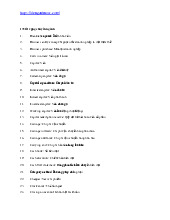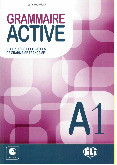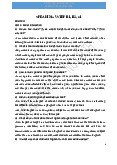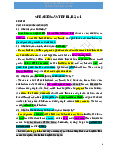







Preview text:
COMPLETING FLOW CHARTS Exercise 1: Flow chart 1. London university
Paragraph 2, line 1-> 4: “Stark was born in Paris in 1893. Although
she had no formal education as a child, ... She entered London University in 1912.”
Dịch: Stark sinh ra tại Paris vào năm 1893. Mặc dù cô ấy không có
lớp giáo dục chính quy vào lúc còn nhỏ.... Cô ấy đã gia nhập vào
trường đại học London vào năm 1912. 2. Nurse corps
Paragraph 2, line 5&6: “She joined the nure corps and was sent to Italy”.
Dịch: Cô ấy đã tham gia vào đội y tá của quân đội và được gửi đến Italy. 3. Arabic
Paragraph 3, line 2,3,4: “She travelled to the Lebanon in 1927 at
the age of 33 when she had saved enough money, and while there, she studied Arabic”.
Dịch: Cô ấy đã du lịch đến Lebanon vào năm 1927 lúc 33 tuổi khi mà
cô ấy đã để dành đủ tiền, và khi còn ở đây, cô ấy đã học tiếng Ả Rập. 4. Donkey
Paragraph 3, line 5,6,7: “In 1928, she travelled by donkey to the
Jebel Druze, a moutainous area in Syria”.
Dịch: Vào năm 1928, cô ấy đã du lịch bằng một con lừa đến Jebel
Druze, một vùng núi tại Syria. 5. Golden Medal
Paragraph 3, line 16,17,18,19: “...which she wrote about in Valley
of the Assassins (1934), a classic for which she was awarded a Gold
Medal by the Royal Geographic Society”.
Dịch: ...cái mà cô ấy đã viết về trong quyển “Valley of the Assassins”
(1934), một tác phẩm kinh điển mà cô ấy đã được nhận huy chương
Vàng bởi Hiệp hội Địa lý Hoàng gia Anh. 6. Career
Paragraph 3, line 20->23: “For the next 12 years, she continued her
career as a traeller and writer.... of the Middle East”.
Dịch: Trong 12 năm tiếp theo, cô ấy tiếp tục sự nghiệp là nhà thám
hiểm và người viết sách (tác giả).... của vùng Trung Đông. Sentences: 1. Heroes
Paragraph 1, line 1&2: “Freya Stark was an explorer who lived
during a time when explorers were regarded as heroes”.
Dịch: Freya Stark đã là một nhà thám hiểm, người mà đã sống trong
suốt thời gian, khi mà những nhà thám hiểm được công nhận như những anh hùng. 2. World War
Paragraph 2, line 4&5: “She entered London University in 1912,
but at the start of World War I, she joined the nurse corps and was sent to Italy”
Dịch: Cô ấy đã gia nhập vào trường đại học London vào năm 1912,
nhưng vào lúc bắt đầu Chiến tranh thế giới thứ nhất, cô ấy đã tham
gia vào đội y tá của quân đội và được gửi đến Italy. 3. A map
Paragraph 3, line 9->11: “She went to a distant region of Elburz, a
moutain range in Iran, where she made a map”.
Dịch: Cô ấy đã đi đến một vùng xa xôi của Elburz, một dãy núi của
Iran, nơi mà cô ấy đã làm một cái bản đồ. 4. Ancient Muslim
Paragraph 3, line 12,13,14: “She was searching for information
about an ancient Muslim sect known as the Assassins...”.
Dịch: Cô ấy đã nghiên cứu thông tin về người Hồi giáo cổ đại được
biết đến như Hội sát thủ... Exercise 2:
Questions 1-6: Summarry completion 1. D (characteristics)
Paragraph 1, line 2,3: “...depending on the regional conditions and
climate, range in length (from 25 – 125 cm), shape and maturity periods...”.
Dịch: Tùy theo điều kiện và khí hậu của từng vùng mà có phạm vi
chiều dài (từ 25-125cm), hình dạng và thời kỳ chín muồi. 2. E (honey)
Paragraph 2, line 3&4: “Bees collect close to 15kg of honey from one hectare of flax field”.
Dịch: Những con ong thu thập gần 15kg mật ong từ một hecta của cánh đồng lanh. 3. C (Spring crop)
Paragraph 3, line 4&5: “Long-stalked flax is grown for biber and
cultivated as a spring crop...”
Dịch: Loại lanh cuống dài lớn lên để lấy xơ và được nuôi trồng trong vụ xuân.. 4. H (damp, warm weather)
Paragraph 3, line 4,5,6: “Long-stalked flax is grown for biber...on
mainly silt or clay in a moist and warm climate”.
Dịch: Loại lanh cuống dài.....trong chủ yếu là phù sa hoặc đất sét với
độ ẩm và khí hậu ấm. 5. K (bright, arid weather)
Paragraph 3, line 8,9: “...crown flax tends to require more sunlight and less moisture...”
Dịch: (crown flax) co xu hướng yêu cầu nhiều ánh sáng hơn và ít độ ẩm hơn... 6. F (commercial purpose)
Paragraph 4, line 4&5: “...remains of food prepared from flaxseed,
and the remains of linen threads, ropes, cloth and fishing nets”.
Dịch: ...thức ăn được chuẩn bị từ hạt lanh, và còn có sợi lanh, dây
thừng, quần áo và lưới bắt cá.
Questions 7-9: Choosing items from the list
7. C: There are many different types of flax plants.
=> Paragraph 1, line 1: “There are over 200 varieties of flax plants”.
Dịch: Ở đây có hơn 200 loại cây lanh đa dạng.
8. E: Separating fiber from the woody portion of flax straw requires at least two weeks.
Paragraph 6, line 7,8,9: “Depending on the method of treatment, it
takes from two to three weeks to complete the process of separating of fibers from the wood”.
Dịch: Dựa vào phương pháp nghiên cứu, mất khoảng từ 2-3 tuần để
hoàn thành quá trình tách sợi khỏi cây.
9. B: The ancients could produce very fine linen cloth.
Paragraph 5, line 3->6: “There is evidence that as far back as 3000-
4000 years BC flax was grown for fiber in Mesopotamia and Egypt
where the finest linen cloths were made”.
Dịch: Đây là bằng chứng rằng quay lại 3000-4000 năm trước Công
Nguyên, cây lanh được trồng để lấy sợi ở Mesopotamia và Egypt, nơi
mà những chất liệu vải lanh tốt nhất được làm ra.
Questions 10-13: Completing a flowchart 10. Continuous layer
Paragraph 7, line 1,2: “The straw stems are spread out a continuous even layer...”.
Dịch: Những thân cây rơm được trải ra những lớp đều liên tục.. 11. Woody central
Paragraph 7, line 4,5&6: “the straw stems are first crushed and
broken in breaking machines to separate the woody central portion of the flax stem”.
Dịch: Thân cây rơm bị nghiền nát trước và bị đập trong máy đập để
tách phần trung tâm của thân cây lanh. 12. Scraping action
Paragraph 8, line 3,4: “The crude fiber is held tightly near one end
while the free end is subjected to a beating and scraping action”.
Dịch: Phần xơ thô được giữ chặt một phần, còn một phần tự do chịu
tác động đập và cạo. 13. Long fiber
Paragraph 8, line 6,7: “The long fiber is then quality-graded and pressed together”.
Dịch: Những sợi dài sau đó được phân loại chất lượng và được ép lại với nhau. Exercise 3: Flowchart: 1. Pod
Paragraph 1, line 1,2,3: “Ancient man picked the sweet fruit off the
trees and ate it, throwing away the seeds. The pod of the cacao tree
tasted sweet, like apricots, whereas the beans – or seeds – inside the pod were bitter”.
Dịch: Người cổ đại hái trái ngọt trên cây xuống và ăn nó, vứt hạt đi.
Vỏ cacao có vị ngọt, như quả mơ, trong khi hạt bên trong vỏ có vị đắng. 2. Olmecs
Paragraph 2, line 1,2: “The Olmecs (1200 to 300 BC) were an
ancient tribes from South Central Mexico. They were the first to
grow cacao plant and use the beans”.
Dịch: Người Olmec là bộ lạc cổ đại đến từ vùng Nam Trung Bộ
Mexico. Họ là người đầu tiên trồng cây cacao và sử dụng hạt cacao. 3. Corn
Paragraph 3, line 2: “..the beans were mix with corn and
flavourings to make savoury meals”.
Dịch: Hạt cacao được trộn với bắp và hương liệu để tạo thành món ăn ngon. 4. Currency
Paragraph 4, line 1,2: “The Aztecs used the cacao bean as their form of curreny...”.
Dịch: Người Aztec sử dụng hạt cacao như là một dạng tiền tệ... 5. Sweet
Paragraph 7, line 4: “The Spanish settlers began drinking chocolate hot and sweet”.
Dịch: Người Tây Ban Nha định cư bắt đầu uống socola nóng và ngọt. 6. Wedding
Paragraph 8, line 1: “It took a royal wedding to make chocolate a star in Europe”.
Dịch: Phải mất một đám cưới hoàng gia để biến socola trở thành ngôi sao ở châu Âu. 7. House’s
Paragraph 8, line 5: “Hot chocolate was served in ‘chocolate houses’...”
Dịch: Socola nóng được phục vụ trong ‘những ngôi nhà socola’.. Sentences: 1. Apricots
Paragraph 1, line 2,3: “The pod of the cacao tree tasted sweet, like apricots”.
Dịch: Vỏ của cacao có vị ngọt, giống như quả mơ. 2. Roasting cacao’s beans.
Paragraph 1, line 5: “When the beans fell into a fire and roasted, releasing a chocolate”.
Dịch: Khi hạt cacao được cho vào lửa và được rang lên, để lại socola... 3. Small rabbit
Paragraph 4, line 4: “1 small rabbit = 30 cacao beans”.
Dịch: 1 con thỏ nhỏ = 30 hạt cacao. 4. Guests
Paragraph 8, line 3,4: “Hot chocolate was served the wedding and
the bride’s guests loved it”.
Dịch: Socola nóng đã được phục vụ trong tiệc cưới và những vị khách của cô dâu yêu nó. 5. Expensive
Paragraph 8, line 4: “Although chocolate was expensive, its
popularity spread in France and England”.
Dịch: Mặc dù socola thì đắt nhưng sự phổ biến của nó đã lan rộng ở Pháp và Anh. END




